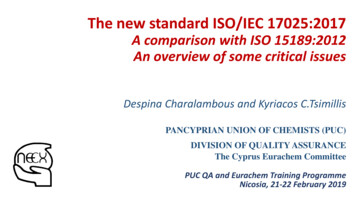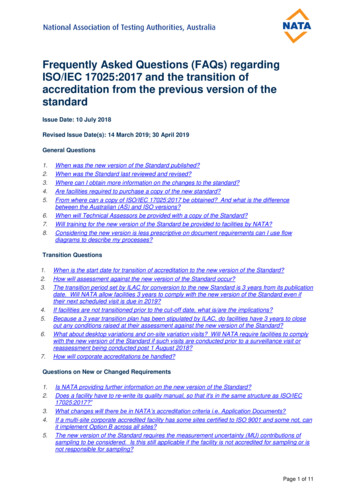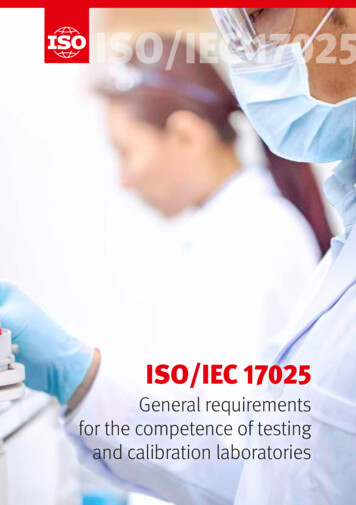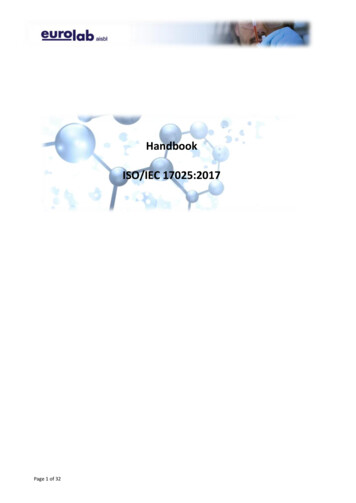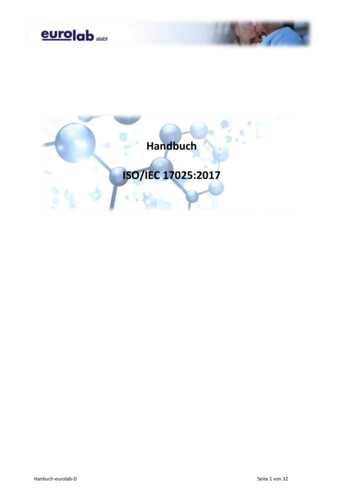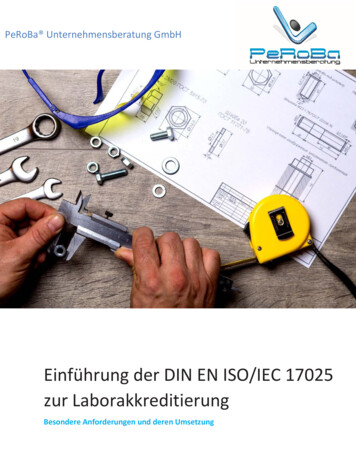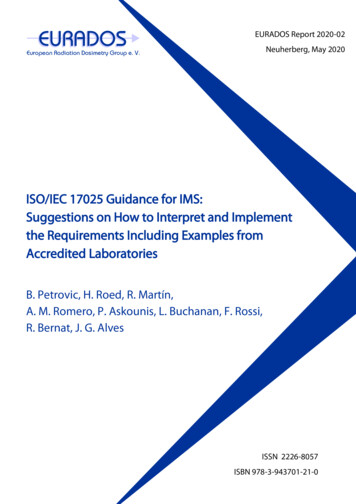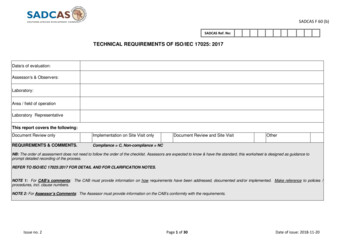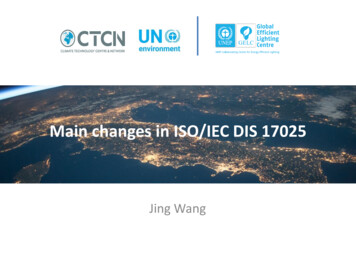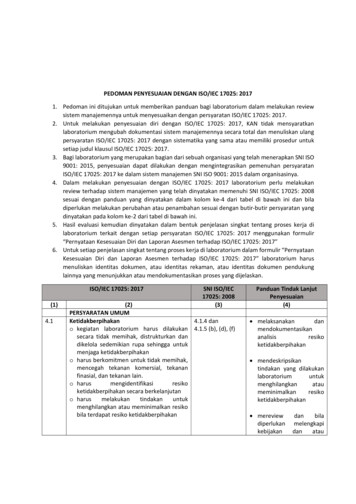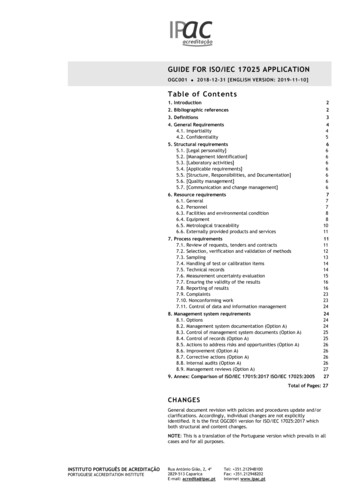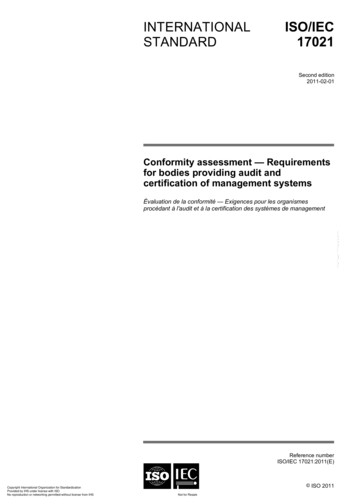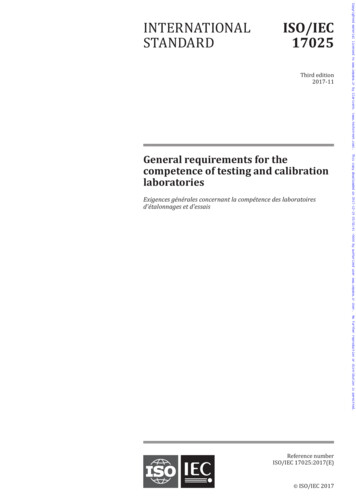
Transcription
ISO/IEC17025Third edition2017-11Exigences générales concernant la compétence des laboratoiresd'étalonnages et d'essaisThis copy downloaded on 2017-12-19 05:56:41 -0600 by authorized user www.sepana.ir User.General requirements for thecompetence of testing and calibrationlaboratoriesCopyrighted material licensed to www.sepana.ir by Clarivate. (www.techstreet.com).INTERNATIONALSTANDARDNo further reproduction or distribution is permitted.Reference numberISO/IEC 17025:2017(E) ISO/IEC 2017
Copyrighted material licensed to www.sepana.ir by Clarivate. (www.techstreet.com).ISO/IEC 17025:2017(E) This copy downloaded on 2017-12-19 05:56:41 -0600 by authorized user www.sepana.ir User. ISO/IEC 2017, Published in SwitzerlandAll rights reserved. Unless otherwise specified, no part of this publication may be reproduced or utilized otherwise in any formor by any means, electronic or mechanical, including photocopying, or posting on the internet or an intranet, without priorwritten permission. Permission can be requested from either ISO at the address below or ISO’s member body in the country ofthe requester.ISO copyright officeCh. de Blandonnet 8 CP 401CH-1214 Vernier, Geneva, SwitzerlandTel. 41 22 749 01 11Fax 41 22 749 09 47copyright@iso.orgwww.iso.orgii ISO/IEC 2017 – All rights reservedNo further reproduction or distribution is permitted.COPYRIGHT PROTECTED DOCUMENT
Contents PageForeword.vIntroduction. vi123467Terms and definitions. 1General requirements. 34.1Impartiality. 34.2Confidentiality. 3Structural requirements. 4Resource requirements. 56.1General. 56.2Personnel. 56.3Facilities and environmental conditions. 66.4Equipment. 66.5Metrological traceability. 86.6Externally provided products and services. 8Process requirements. 97.1Review of requests, tenders and contracts. 97.2Selection, verification and validation of methods. 107.2.1Selection and verification of methods. 107.2.2Validation of methods. 117.3Sampling. 127.4Handling of test or calibration items. 127.5Technical records. 137.6Evaluation of measurement uncertainty. 137.7Ensuring the validity of results. 137.8Reporting of results. 147.8.1General. 147.8.2Common requirements for reports (test, calibration or sampling). 157.8.3Specific requirements for test reports. 157.8.4Specific requirements for calibration certificates. 167.8.5Reporting sampling – specific requirements. 167.8.6Reporting statements of conformity. 177.8.7Reporting opinions and interpretations. 177.8.8Amendments to reports. 177.9Complaints. 177.10 Nonconforming work. 187.11 Control of data and information management. 19Management system requirements.198.1Options. 198.1.1General. 198.1.2Option A. 208.1.3Option B. 208.2Management system documentation (Option A). 208.3Control of management system documents (Option A). 208.4Control of records (Option A). 218.5Actions to address risks and opportunities (Option A). 218.6Improvement (Option A). 228.7Corrective actions (Option A). 228.8Internal audits (Option A). 238.9Management reviews (Option A). 23 ISO/IEC 2017 – All rights reserved iiiNo further reproduction or distribution is permitted.8Normative references. 1This copy downloaded on 2017-12-19 05:56:41 -0600 by authorized user www.sepana.ir User.5Scope. 1Copyrighted material licensed to www.sepana.ir by Clarivate. (www.techstreet.com).ISO/IEC 17025:2017(E)
Annex A (informative) Metrological traceability.25Annex B (informative) Management system options.27Bibliography. 29Copyrighted material licensed to www.sepana.ir by Clarivate. (www.techstreet.com).ISO/IEC 17025:2017(E) This copy downloaded on 2017-12-19 05:56:41 -0600 by authorized user www.sepana.ir User.No further reproduction or distribution is permitted.iv ISO/IEC 2017 – All rights reserved
ForewordISO (the International Organization for Standardization) is a worldwide federation of nationalstandards bodies (ISO member bodies). The work of preparing International Standards is normallycarried out through ISO technical committees. Each member body interested in a subject for whicha technical committee has been established has the right to be represented on that committee.International organizations, governmental and non-governmental, in liaison with ISO, also take part inthe work. In the field of conformity assessment, ISO and the International Electrotechnical Commission(IEC) develop joint ISO/IEC documents under the management of the ISO Committee on Conformityassessment (ISO/CASCO).Attention is drawn to the possibility that some of the elements of this document may be the subject ofpatent rights. ISO shall not be held responsible for identifying any or all such patent rights. Details ofany patent rights identified during the development of the document will be in the Introduction and/oron the ISO list of patent declarations received (see www.iso.org/patents).Any trade name used in this document is information given for the convenience of users and does notconstitute an endorsement.For an explanation on the voluntary nature of standards, the meaning of ISO specific terms andexpressions related to conformity assessment, as well as information about ISO's adherence to theWorld Trade Organization (WTO) principles in the Technical Barriers to Trade (TBT) see the followingURL: www.iso.org/iso/foreword.html.This document was prepared by the ISO Committee on Conformity Assessment (CASCO) and circulatedfor voting to the national bodies of both ISO and IEC, and was approved by both organizations.This third edition cancels and replaces the second edition (ISO/IEC 17025:2005), which has beentechnically revised.— the risk-based thinking applied in this edition has enabled some reduction in prescriptiverequirements and their replacement by performance-based requirements;— there is greater flexibility than in the previous edition in the requirements
will also operate generally in accordance with the principles of ISO 9001. This document requires the laboratory to plan and implement actions to address risks and opportunities. Addressing both risks and opportunities establishes a basis for increasing the effectiveness of the management system, achieving improved results and preventing negative effects. The laboratory is responsible for .
